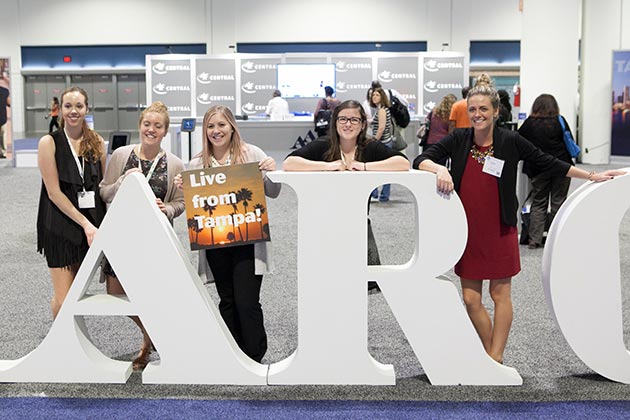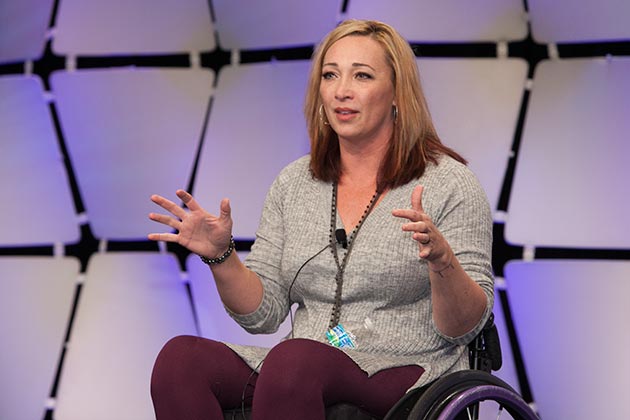Show your appreciation

If your hospital or other organization funded your trip to Tampa this week, be sure to send your supervisors a written thank you note when you get back home — and let them know you’d love to share the knowledge you learned with fellow staff members as well.
Saying “thanks” and offering to host a “lunch and learn” or other educational session will help ensure that you’ll once again get the go-ahead when you request funding for next year’s meeting in San Antonio.
Phil Kittredge Memorial Lecture — E-Cigs: What Does the Evidence Say?
 Nathan Cobb, MD, delivers the Phil Kittredge Memorial Lecture
Nathan Cobb, MD, delivers the Phil Kittredge Memorial Lecture
Respiratory therapists and other clinicians are getting more and more questions from patients who smoke about the advisability of using the e-cigarette as a stop smoking aid.
Many therapists would say “no way,” but it’s more complicated than that, said Nathan Cobb, MD, during this morning’s Phil Kittredge Memorial Lecture.
Dr. Cobb said he first became involved in the e-cigarette debate when an intern walked into his office with one of the devices and asked him what he knew about it. Turns out the answer was not much.
So they took the device apart and sent it to a lab to be tested. His interest in the area grew and he began looking at a variety of factors involved with these products.
He shared much of what he has learned with his audience, noting e-cigarettes started out looking like combustable cigarettes, but many of the newer devices coming on the market today barely show a resemblance.
Safety concerns range from the use of lithium ion batteries to drive the products to the addition of propylene glycol to produce the vapor. Fears that the batteries could explode have led to new rules banning the devices from being packed in baggage on airplanes, and while propylene glycol is generally accepted as safe, it’s use in a vaporized form has not been well studied.
Supply chain issues comes into play as well, with some small manufacturers outside of the U.S. substituting the much more dangerous dynalene glycol for the less dangerous propylene glycol in these devices. Dynalene glycol, noted the physician, is highly toxic and can lead to renal failure.
But despite the negatives, the assistant professor at Georgetown University Medical School and physician at Medstar Georgetown Hospital suggested to his audience that e-cigarettes may still have a place in the tobacco cessation world. Number one, they are not really cigarettes because they don’t contain tobacco. Number two, current nicotine replacement therapies (NRTs), although safe and effective, have fallen short of expecations.
“That is what gets people excited,” he said. “If they really are like nicotine replacement, they could change the end game of tobacco.”
Dr. Cobb said he is not aware of any failed trials on NRT, but getting patients to stick with these products has proved to be an uphill battle and thus they have not really resulted in widespread quitting.
He went on to cite several studies that have been conducted in e-cigarettes, including one trial that compared a placebo e-cigarette to the nicotine patch. The patch didn’t outperform the e-cigarette, suggesting there may be something about these devices that make them appealing to the user.
Another study found people who use e-cigarettes puff harder on them than they do on combustable cigarettes, which indicates people don’t use these devices the same way they use traditional cigarettes.
So, maybe the answer is to harness the appeal of e-cigarettes to help people quit and maybe even drive combustable cigarettes off the market for good, suggested the physician. Science has been conducted in that direction too, including a recent study out of Duke that found bonding the nicotine to pyruvate boosted the nicotine dose delivered by the e-cigarette.
The troubling thing about that study, however, is the fact that the intellectual property was promptly sold to Phillip Morris. And that leads to the question, if and/or when the FDA decides to regulate e-cigarettes, thus making them safer for the consumer, who will make them?
According to Dr. Cobb the pharmaceutical companies have shown no interest, and that leaves the tobacco companies. Tobacco companies are already investing in the e-cigarette market in droves, and he believes that’s a real concern because clearly their mission will not be to help people quit all forms of nicotine for good.
What does he tell his patients about e-cigarettes, and what should respiratory therapists tell theirs?
First and foremost, Dr. Cobb advocates for the use of traditional NRT products to people who ask him for advice on quitting. But if a smoker says he is having some success getting off combustable cigarettes with the use of an e-cigarette, his advice is “don’t rock the boat.” He does, however, recommend that they purchase the product only from one of the larger independent manufacturers rather than from a tobacco company or one of the smaller, random sellers out there today.
The goal, he said, is to people get off combustable tobacco. “Anything that helps you do that is worth doing.”
Put Me in Coach, I’m Ready to Play: Extending Your Services to the Outpatient Clinic

Respiratory therapists are key players in outpatient pulmonary rehabilitation programs. But in a reimbursement environment driven by penalties for excessive readmissions and patient satisfaction, could they play a larger role in other outpatient settings as well?
Yes, says Arianna Villa, BS, RRT, case coordinator and study coordinator for the pulmonary rehabilitation program at the University of California San Diego, and she proved her point in a talk this morning that took a closer look at two outpatient clinics at her hospital that include RTs on the interdisciplinary team.
“In the last couple of years we’ve expanded to outpatient clinics, and that’s been really exciting to do,” she told her audience.
Villa says the involvement of RTs in these clinics grew out of the recognition that therapists can bring the same disease management skills they employ in pulmonary rehab to bear on other patient populations. Collaborating with other hospital departments and specialists across the continuum was key.
She specifically addressed the therapist’s role in the Airway Clinic and the ALS Clinic.
The Airway Clinic sees patients with COPD and asthma and the care team consists of pulmonologists, nurses, and RTs. Therapists carefully review the patient’s chart before the first visit to make sure they understand the person’s condition, what medications he may be taking, and his treatment needs and goals. If the patient has been to the clinic before, previous records are reviewed as well.
During clinic, therapists are charged with performing patient assessments using the COPD Assessment Test and Asthma Control Test, reviewing inhalers and inhaler technique, reviewing peak flow results with asthma patients, developing action plans, and conferring with physicians to determine if any additional orders or referrals are needed.
Villa believes the latter is especially important. “The best part of the clinic is we get a lot of one-on-one with the physician,” she said, noting that often the therapists will learn things about the patient that the physician might not hear. For example, a patient may feel comfortable saying to his RT, “I’m not going to take that medication,” when he would never have the nerve to share that bit of information when talking to the physician.
Established to manage patients with amyotrophic lateral sclerosis (ALS), the bi-monthly ALS Clinic is run by a multidisciplinary team including the neurologist, nurse coordinator, speech therapist, occupational therapist, physical therapist, nutritionist/dietician, social worker, and respiratory therapist. Respiratory therapists conduct a complete respiratory assessment encompassing age and demographics, history of respiratory disease, spirometry, and patient complaints.
Based on spirometry results, various treatment approaches may be recommended, ranging from cough assist devices to noninvasive ventilation to invasive mechanical ventilation. Immediately following the patient visit the team gathers to discuss treatment goals going forward and the RT’s input is considered critical in helping to guide the type of equipment ordered and initial settings, among other factors.
“You get to sit down at the table and share notes,” she said.
What does it take to step into one of these roles? Villa said therapists need to have the ability to communicate effectively with physicians and other colleagues, they must be well-versed in patient assessment and the treatment options for each population, and they need to have a good understanding of the “outpatient world” (i.e., DME companies, equipment, and insurance).
What if you don’t have all of these skills right now? Villa concluded her talk by identifying a host of resources available — including many from the AARC — to help you get up to speed.
PEP Up Your Pulmonary Rehab Program

The pulmonary rehabilitation program at Barnes Jewish Hospital in St. Louis, MO, was like a lot of PR programs across the country in that clinicians worked hard to deliver education to their patients but didn’t really have a standardized method to follow and simply used a generalized and anecdotal process to determine what to cover and when.
Their outcomes reflected these shortcomings, with 50% of patients failing to master basic skills on an assessment test created to gauge the effectiveness of the educational component.
Enter the COPD Foundation’s Pulmonary Education Program (PEP). Designed by thought leaders in the field along with substantial input from patients and families, the program aims to provide PR programs with a comprehensive set of tools they can use to achieve the outcomes they most desire for their patients.
It has worked wonders at her hospital, said Deborah Bennett, BS, RRT, in a presentation earlier today.
According to the pulmonary rehab supervisor, her PR program set out to implement PEP with every patient enrolled in the non-lung transplant segment of the program, train every therapist to deliver education in a consistent manner using the tools, and standardize the work of patient education and assessment. They used a Lean Six Sigma process to accomplish their goals.
It began by identifying the scope of the project and assessing the initial state. “We wanted to ensure every therapist would be able to consistently perform this educational process in a consistent manger,” said Bennett.
Problems identified by the assessment ranged from a lack of coordination among staff on resources used to the fact that the current setting for patient education (their small gym) was not conducive to the learning process.
“One therapist might use a picture handout but the next therapist might not,” said Bennett. The gym did not allow for a calm and quiet environment to concentrate on learning.
The goal: have 100% of patients demonstrate basic disease management skills upon graduating from the PR program, as reflected by a 90% score or above on the assessment test.
Bennett said they turned to the PEP Program after learning about it at the 2013 AARC Congress. “We got back home, contacted the COPD Foundation, and decided this was a match for us,” she said.
Following through the rest of the Six Sigma process, they put the program into operation. Learning tools were standardized and a dedicated space was found for education where therapist and patient would not be disturbed.
The Standard Work forms are used to deliver education to patients over the first four PR sessions. At the initial session, each patient receives the PEP Program materials, including a “Start Your Engines Checklist” that covers testing for Alpha-1, why they should join the COPD Registry, and opportunities for them to become a COPD advocate.
That 50% mastery of basic skills rate seen before PEP went into operation very quickly rose to 100% and has remained at 100% for most of the months since. Bennett says she’s gotten a wealth of great feedback from her staff as well, who appreciate having these formal tools to use when educating their patients.
Said one staff member, “It’s nice having a systematic approach with the materials at hand when needed.”
Sputum Bowl 2015: Top honors go to North Carolina and Nevada
The competition was fierce during last night’s Medtronic Sputum Bowl Finals as teams from across the country battled it out for the top prizes. The winners are —
National Bowl
First place: North Carolina
Second place: Missouri
Third place: Ohio and Minnesota (tie)
Student Bowl
First place: Nevada
Second place: Florida
Third place: Iowa and Minnesota (tie)
Congratulations to these winners and all of our Sputum Bowl competitors this year!
Closing Ceremony — Overcoming Obstacles
 Amy Van Dyken
Amy Van Dyken
Six-time Olympic Gold Medalist Amy Van Dyken didn’t need a respiratory therapist when she almost died several times in the ICU after suffering a near fatal ATV accident in June of 2014 that severed her spinal cord and left her paralyzed from the waist down. But she was always happy to know they were in the room just in case.
How did this world class swimmer turned sports broadcaster even know RTs were standing by?
Turns out, Van Dyken has had a long association with RTs that began when she was diagnosed with severe asthma as a small child.
In and out of the hospital with acute attacks, she remembers her therapists as the folks who would stay by her side and hold her hand when her mom couldn’t be there with her.
“Respiratory therapists were my best friends,” she told the audience.
Van Dyken amazed attendees with her struggle to overcome her asthma, her record-breaking success as an Olympic swimmer, and the journey she is now on to overcome paraplegia.
If you were in the audience on Tuesday, you know there is nothing that will keep this young woman from pursuing her goals.
If you weren’t stay tuned to your January issue of AARC Times for more on Amy Van Dyken, her Olympic career and her ATV accident, and her asthma and how she feels about the respiratory therapists who have played an integral role in her care.
See you in San Antonio!

The AARC will head to San Antonio, TX, for AARC Congress 2016 and the city promises to welcome us with open arms. So pencil in the dates on your calendar now — Saturday-Tuesday, October 15–18 — and plan to join us for the biggest and most influential respiratory care meeting in the world.
